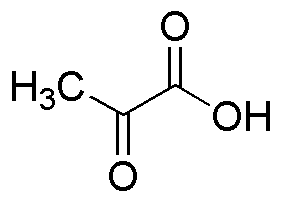Pyruvic acid is widely utilized in research focused on:
- Metabolic Studies: It plays a crucial role in cellular metabolism, making it essential for researchers studying energy production and metabolic pathways in cells.
- Food Industry: Used as a food preservative and flavoring agent, it helps enhance the taste and shelf life of various products, appealing to manufacturers seeking natural additives.
- Pharmaceutical Development: Pyruvic acid is a key component in the synthesis of various pharmaceuticals, offering advantages in drug formulation due to its ability to improve solubility and bioavailability.
- Biotechnology: In fermentation processes, it serves as a substrate for microbial growth, aiding in the production of biofuels and biochemicals, which is vital for sustainable practices.
- Cosmetic Applications: Its properties are leveraged in skincare products for promoting skin health and rejuvenation, appealing to consumers looking for effective and natural skincare solutions.
General Information
Properties
Safety and Regulations
Applications
Pyruvic acid is widely utilized in research focused on:
- Metabolic Studies: It plays a crucial role in cellular metabolism, making it essential for researchers studying energy production and metabolic pathways in cells.
- Food Industry: Used as a food preservative and flavoring agent, it helps enhance the taste and shelf life of various products, appealing to manufacturers seeking natural additives.
- Pharmaceutical Development: Pyruvic acid is a key component in the synthesis of various pharmaceuticals, offering advantages in drug formulation due to its ability to improve solubility and bioavailability.
- Biotechnology: In fermentation processes, it serves as a substrate for microbial growth, aiding in the production of biofuels and biochemicals, which is vital for sustainable practices.
- Cosmetic Applications: Its properties are leveraged in skincare products for promoting skin health and rejuvenation, appealing to consumers looking for effective and natural skincare solutions.
Documents
Safety Data Sheets (SDS)
The SDS provides comprehensive safety information on handling, storage, and disposal of the product.
Product Specification (PS)
The PS provides a comprehensive breakdown of the product’s properties, including chemical composition, physical state, purity, and storage requirements. It also details acceptable quality ranges and the product's intended applications.
Certificates of Analysis (COA)
Search for Certificates of Analysis (COA) by entering the products Lot Number. Lot and Batch Numbers can be found on a product’s label following the words ‘Lot’ or ‘Batch’.
*Catalog Number
*Lot Number
Certificates Of Origin (COO)
This COO confirms the country where the product was manufactured, and also details the materials and components used in it and whether it is derived from natural, synthetic, or other specific sources. This certificate may be required for customs, trade, and regulatory compliance.
*Catalog Number
*Lot Number
Safety Data Sheets (SDS)
The SDS provides comprehensive safety information on handling, storage, and disposal of the product.
DownloadProduct Specification (PS)
The PS provides a comprehensive breakdown of the product’s properties, including chemical composition, physical state, purity, and storage requirements. It also details acceptable quality ranges and the product's intended applications.
DownloadCertificates of Analysis (COA)
Search for Certificates of Analysis (COA) by entering the products Lot Number. Lot and Batch Numbers can be found on a product’s label following the words ‘Lot’ or ‘Batch’.
*Catalog Number
*Lot Number
Certificates Of Origin (COO)
This COO confirms the country where the product was manufactured, and also details the materials and components used in it and whether it is derived from natural, synthetic, or other specific sources. This certificate may be required for customs, trade, and regulatory compliance.


